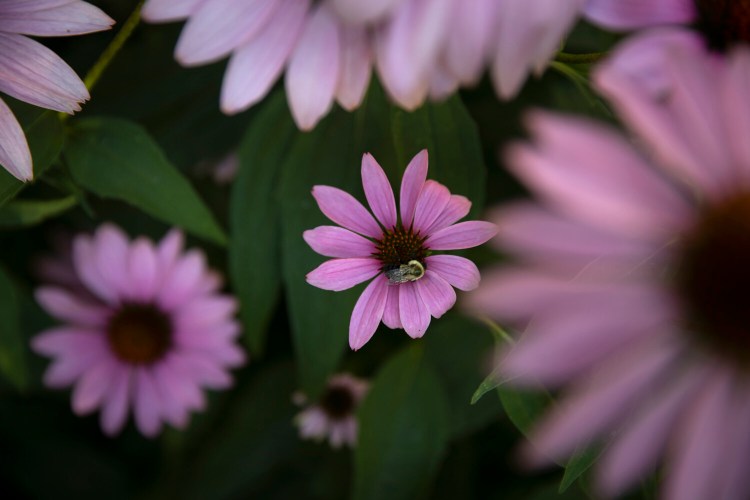The goal of all homeowners and the landscape gardeners they hire should be to increase the property’s biodiversity.
They key word is “increase.” By their very existence, homes and the people who live in them, take away some of the native plants and the animals that depend on them.
The damage can and should be limited, Justin Nichols said in an online talk earlier this month sponsored by the Maine Landscape and Nursery Association and Coastal Maine Botanical Gardens.
Nichols is a self-employed horticulturist working mostly from Harpswell to Portland. For nine years before starting his own business he worked as a horticulturist at the botanical gardens. Most of the projects he described in his talk were aimed at revising existing landscapes that featured a lot of lawn and non-native plants.
The work often begins with the soil. One site, for instance, featured some apple trees that were not doing well. He began digging around the roots to see what was wrong.
“When I got done, I had removed 10 wheelbarrows full of mulch that had been sitting on top of landscape fabric,” Nichols said.
He found no insects, beneficial or not, in the mulch, and while there was evidence that fertilizer had been spread on top of the mulch, he wasn’t sure any of it had ever reached the roots.
At another home, the owner wanted Nichols to create a New England meadow, but below the lawn – which had been regularly fertilized and treated with pesticides – was construction fill, which would not support anything but desert plants. He added a lot of compost and good topsoil in that area, noting that “microbiotics in the soil are also part of plant diversity.” Unhealthy soil will not support healthy plants.
Another client complained that she had seen only one butterfly all year. “That job was really low-hanging fruit,” Nichols said. He simply created a landscape that didn’t depend on pesticides made out of synthetic chemicals. Some crabgrass crept into the lawn, but the owner was willing to make the trade in order to get the butterflies.
Nichols’s landscape philosophy tends toward native plants and organic gardens, but he makes some exceptions. Many non-native plants are a great benefit for pollinators, he said.
In creating gardens, he often has to negotiate with the clients. One client was perfectly happy with native plants, but she wanted some catmint, which isn’t native. That was fine.
Another wanted to keep some Korean lilacs, blue hydrangeas and a dappled willow but approved planting blueberry sod on a slope next to the woods, which not only limited erosion but provided food for several kinds of wildlife, including birds and native bees. He added other natives such as buttonbush (Cephalanthus) and winterberry, along with coralberry (Symphoricarpos orbiculatus), which is native to New York but not Maine.
Nichols enjoys doing these “lawn conversions,” as he calls them. You might think you’d have to dig up or till in the lawn to get rid of it before replanting the area with meadow plants. Nichols uses a different method: He steps onto the lawn and places flags where he thinks he will want meadow plants. He then goes back to the viewing point at the house to see how the arrangement looks, returning to the lawn to move the flags around for best effect.

A monarch lands on a swamp milkweed plant in North Berwick. Plant native perennials and watch the biodiversity in your garden expand. Derek Davis/Staff Photographer Buy this Photo
Then he plants seedlings of native perennials, like Joe Pye weed, goldenrod, rudbeckia, echinacea, asters, milkweeds and such. In one conversion, he used 50 different species of plants. European lawn grasses look OK growing around the plants, he said, and in time the natives will overtake the grasses, creating the meadow.
Note: I was absolutely thrilled to find this online class. Like many others, I have kept busy during the pandemic by gardening, taking walks and enjoying outdoor activities. I held the hope that by the time the cold weather hit, the pandemic would be fading. Current statistics have quashed that hope.
These online classes will be a great escape until spring. The Coastal Maine Botanical Garden is offering several programs. The state’s annual Agricultural Trades Show will be virtual from Jan. 19 to 23.
After attending Nichols program, I signed up for another talk jointly sponsored by the Maine Organic Farmers and Gardeners Association and the Harpswell Garden Club. Check out these groups’ websites and sign up for something. It will be better than bingeing on soap operas and Netflix.
Tom Atwell is a freelance writer gardening in Cape Elizabeth. He can be contacted at: tomatwell@me.com.
Send questions/comments to the editors.



Success. Please wait for the page to reload. If the page does not reload within 5 seconds, please refresh the page.
Enter your email and password to access comments.
Hi, to comment on stories you must . This profile is in addition to your subscription and website login.
Already have a commenting profile? .
Invalid username/password.
Please check your email to confirm and complete your registration.
Only subscribers are eligible to post comments. Please subscribe or login first for digital access. Here’s why.
Use the form below to reset your password. When you've submitted your account email, we will send an email with a reset code.